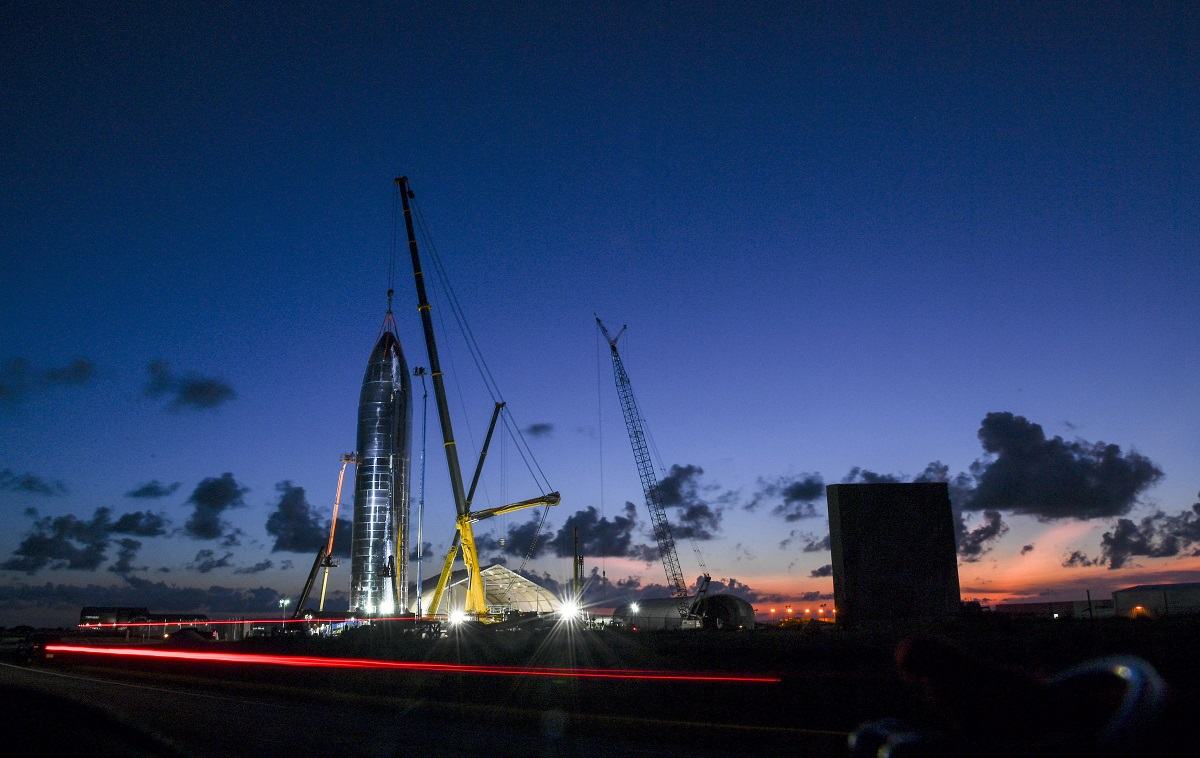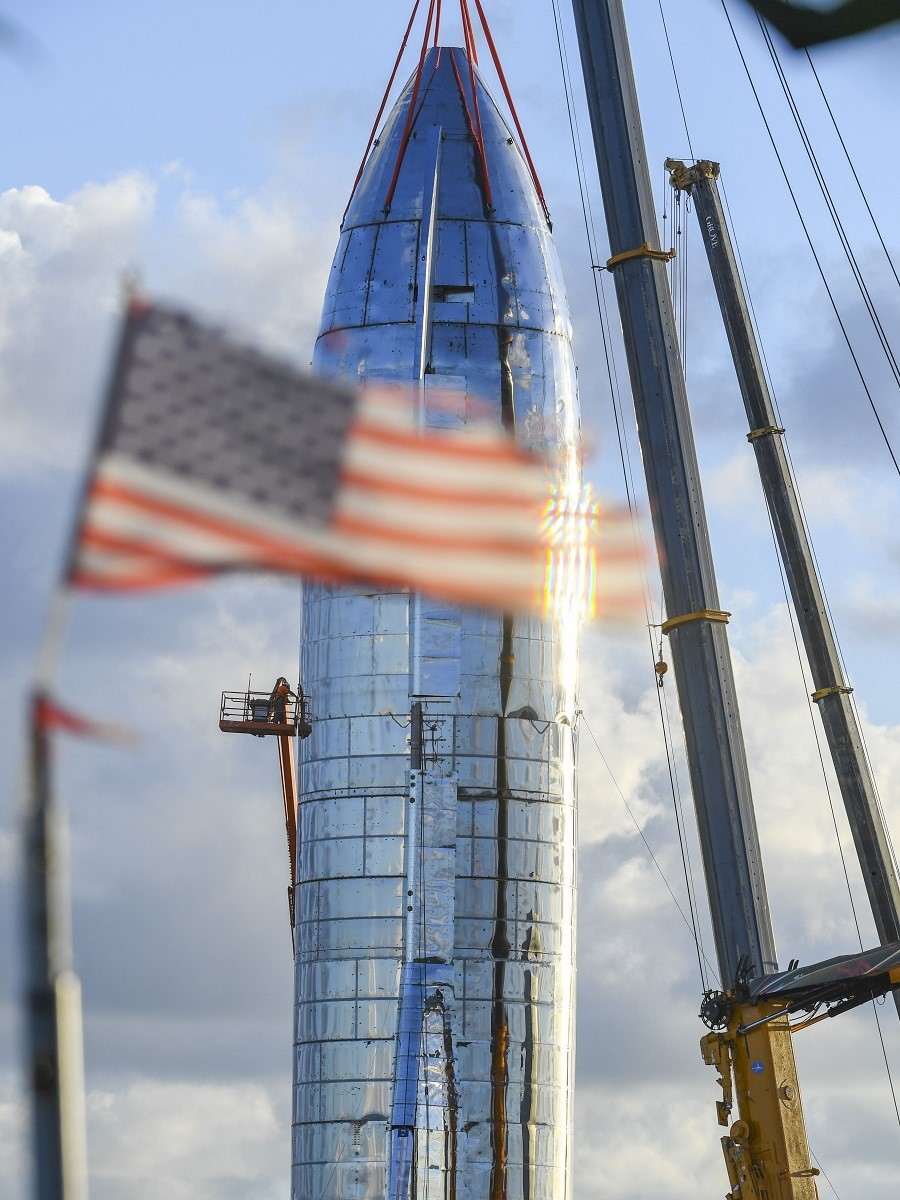
Workers put the finishing touches on the Starship prototype in Texas in September.
12:12 JST, April 17, 2023
NASA Administrator Bill Nelson loves to boast about the space agency’s beast of a moon rocket. The Space Launch System is a towering 322 feet, taller than the Statue of Liberty, and, as Nelson likes to point out, “the most powerful rocket in the world.”
For now, at least.
As early as Monday morning, SpaceX is expected to launch, for the first time, its own massive rocket, an almost 400-foot-tall behemoth known as Starship. Powered by a staggering 33 first-stage engines, it would have nearly twice the thrust of the SLS. And unlike NASA’s SLS, which falls into the ocean after its payload is launched, the stainless steel Starship is designed to return to a soft landing on Earth, to be used again.
The Federal Aviation Administration granted SpaceX a license for the launch on Friday, and SpaceX said Sunday it is targeting a 2 1/2-hour window beginning at 8 a.m. Eastern time on Monday for the launch, with other opportunities in the following days if a delay is required.
If the SLS represents a traditional government approach to rocket design – one that uses hardware originally designed in the 1970s for the space shuttle – Starship symbolizes space flight’s modern, entrepreneurial bent. Starship is designed to be refueled in orbit, allowing SpaceX to hoist an unprecedented amount of cargo and potentially dozens of people to deep space. And, because it will be reusable, it is expected to be far less expensive to operate than the SLS.
The promise of Starship and SpaceX CEO Elon Musk’s asserting that the vehicle “could make life on Mars real” have attracted legions of fans. For years, they have jammed Musk’s presentations on the rocket, obsessively tracked its design iterations and made pilgrimages to SpaceX’s Starship facility in a remote corner of South Texas the company calls Starbase.
But Starship also has won over NASA, which has placed the rocket at the center of its exploration goals. In 2021, the space agency awarded SpaceX a $2.9 billion contract to use it as the vehicle that would land astronauts on the surface of the moon, giving it a starring role in NASA’s campaign to return people to the lunar surface as part of its Artemis program.
Its launch will be the first time SpaceX has attempted to fly the full vehicle – the Starship spacecraft mounted on top of the Super Heavy booster. A successful launch would be no small feat, especially given the size and complexity of the rocket. “With a test such as this, success is measured by how much we can learn, which will inform and improve the probability of success in the future as SpaceX rapidly advances development of Starship,” SpaceX said in a statement.
Speaking on Twitter Spaces on Sunday night, Musk explained as he has before that success is not guaranteed. He even suggested the test could be postponed. “It might launch tomorrow,” he said. “But we’re going to be very careful, and if we see anything that gives us concern we will postpone the launch.”
Among the biggest concerns, he said, is an explosion that would destroy the launchpad. “It will take us probably several months to rebuild the launchpad if we melt it,” he said. As for the booster, he compared it to “having a box of grenades. You know, really big grenades.”
If it does fly successfully, Starship would serve not only as a vehicle for exploration, but for science as well. With its ability to hoist enormous amounts of mass to orbit, astronomers and astrophysicists see rethinking what sorts of telescopes and instruments can be catapulted into space.
In its fully reusable configuration, Starship would be able to lift more than 100 metric tons – more than 220,000 pounds – to the moon and even more to low Earth orbit, according to a SpaceX user’s guide from 2020.
By contrast, the current version of SLS is capable of hoisting 27 metric tons, or 59,500 pounds, to the moon, according to NASA. With a pending upgrade, that would increase to 38 metric tons or 83,700 pounds.
“Assuming it is successful, Starship will dramatically enhance our space capabilities in ways that will qualitatively alter how astrophysics missions can be built,” predicted an article in Physics Today written by a trio of astronomers and physicists. ” … Astrophysics missions to space have always been tightly constrained by the capabilities of the launchers, which have not changed substantially in two decades.”
A report last year by the National Academies of Sciences, Engineering and Medicine found that “Starships can accommodate payloads that are significantly larger and heavier than traditional NASA planetary payloads, significantly reducing the need for the costly reductions in size and mass required for traditional NASA payloads.”
“It’s quite simple, really. When you design any missions for astronomy, you’re very limited by the mass available in the rocket,” Martin Elvis, a senior astrophysicist at the Harvard and Smithsonian Center for Astrophysics, said in an interview. The James Webb Space Telescope, for example, had to be designed to be folded so it could be stuffed into the nose cone of the Ariane 5 rocket that shot it to space. The total mass was nearly 14,000 pounds, far less than what Starship would be able to accommodate.
“Your whole development process, your whole design process, becomes so much simpler,” he said. “And that saves enormous amounts of cost.”
Indeed, Starship’s cargo space is so generous that it may take a while for the space industry to grow into it.
“Starship is too big for most payloads today,” said Carissa Christensen, the CEO of Bryce Space and Technology, a consulting firm. “If it is cheap enough, that might not matter. And it could serve as a direct substitute for less capable vehicles in the near term. The real impact will be new concepts that take advantage of the vehicle’s massive capacity. It will take years for the market to design and manufacture payloads that are truly optimized for Starship.”
Starship already has a few customers. Yusaku Maezawa, a Japanese billionaire, has booked a trip around the moon with several other private citizens. Another billionaire, Jared Isaacman, who commanded an all private-citizen flight to orbit on SpaceX’s Dragon spacecraft in 2021, plans to fly on Starship’s first mission with people. It is unclear, however, when either of those flights would occur.
In the near term, SpaceX needs Starship to begin flying regularly so that it can put the next generation of its Starlink internet satellites in orbit. They are more capable than the satellites in the current constellation, which are launched in batches by SpaceX’s Falcon 9 rocket. But the new satellites are much heavier, about 1.25 tons, Musk has said, and would require Starship’s increased power.
But first, SpaceX needs to launch successfully.

A prototype of Starship in September.
SpaceX blew up a series of spacecraft prototypes during an earlier testing campaign, flying them about six miles up, then bringing them back down in landing attempts that ended in fiery explosions until the company finally stuck the landing.
Last year, SpaceX won preliminary approval for its first launch from the Federal Aviation Administration, which required it to take many actions designed to protect the surrounding environment and reduce the impact of its activities on a nearby public beach and wildlife preserve before being given a launch license.
The upcoming launch attempt is far more ambitious than the previous tests. Starship will be stacked on top of the 33-engine Super Heavy booster, which is expected to send Starship speeding around much of the globe before falling back into the atmosphere and crashing into the ocean off the coast of Hawaii.
If the launch fails, Musk said SpaceX would try again soon. “We’re building a whole series of Starships in South Texas, and so I think we’ve got hopefully an 80 percent chance of reaching orbit this year.”
For this attempt, SpaceX will not try to land either Starship or its booster. But eventually it hopes that the booster will fly back to its nearly 500-foot-tall launch tower, where it will be caught by a pair of arms that operate like giant chopsticks.
The Starship spacecraft itself, after completing its mission and reentering Earth’s atmosphere, would flip horizontal, fall back toward Earth in a kind of belly-flop, then right itself, reignite its engines and touch down softly on a landing pad. It’s a technique the company says will allow “missions to destinations across the solar system where runways do not exist.”
Once it’s operational, Musk said, Starship could lower “the cost of access to space by orders of magnitude,” allow people to go to Mars and eventually achieve his goal of making humanity “multi-planetary.”
“We don’t want to be one of those lame one-planet civilizations,” he said.

SpaceX CEO Elon Musk greets a crowd as he provides an update on Starship’s development in Texas in February.
"News Services" POPULAR ARTICLE
-

American Playwright Jeremy O. Harris Arrested in Japan on Alleged Drug Smuggling
-

Taiwan President Shows Support for Japan in China Dispute with Sushi Lunch
-

Japan’s Nikkei Stock Average as JGB Yields, Yen Rise on Rate-Hike Bets
-

Japan’s Nikkei Stock Average Licks Wounds after Selloff Sparked by BOJ Hike Bets (UPDATE 1)
-

Japanese Bond Yields Zoom, Stocks Slide as Rate Hike Looms
JN ACCESS RANKING
-

Japan’s Hopes for Seafood Exports Shot Down in China Spat
-

Keidanren Chairman Yoshinobu Tsutsui Visits Kashiwazaki-Kariwa Nuclear Power Plant; Inspects New Emergency Safety System
-

Japan to Charge Foreigners More for Residence Permits, Looking to Align with Western Countries
-

Imports of Rare Earths from China Facing Delays, May Be Caused by Deterioration of Japan-China Relations
-

Japan Exports Rise in October as Slump in U.S. Sales Eases

























